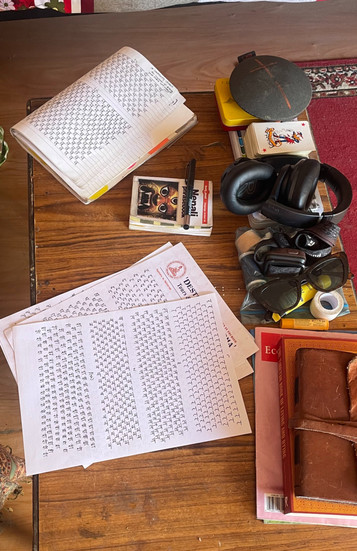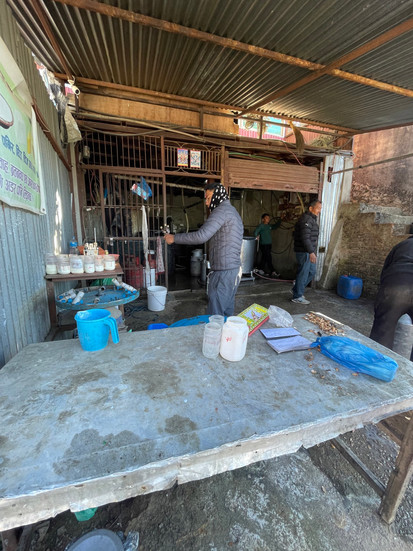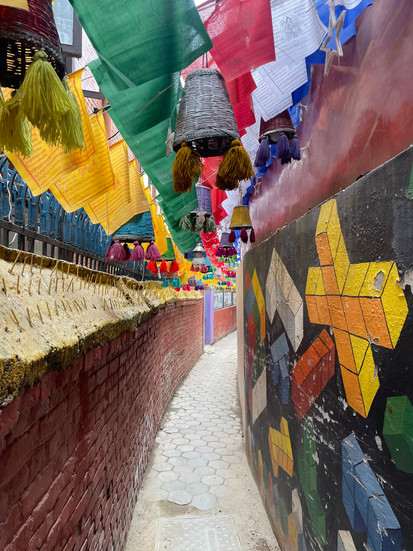Niwari Baby Weaning and House Construction in Nepal
- stemeillon
- Feb 5
- 10 min read
It’s been nearly two months since I arrived in Nepal and I’ve been learning much, about the culture and about myself. I also just learned that the solar program was once again canceled for May, leaving me rattled with a newly open window and too many ideas with not enough follow-through. This post goes through the work I'm doing now, my experience at a Niwari baby weaning ceremony (bottom), and my cultural understandings in Nepal.
I am currently working for a remarkable couple to finish building their house and help set it up as a community healing house for open-minded people. They are both in their early 70s. The woman, Aparna, is nothing short of brilliant and should be the subject of a documentary. She grew up in the upper Brahmin caste, which amongst many regulations prohibited girls from studying. Her rebellious nature and remarkable drive led her to receive full scholarships and receive a PhD in public health in the UK. She built the first hospital in the region 40 years ago, amongst others, and has saved countless lives, mentally and physically. Her husband Greg is from the US, and after years of IT work and caretaking for those around him he traveled to Nepal and met Aparna; they were married a few years later and he now lives here full time.
Aparna has a house about an hour east of Kathmandu, half an hour walk from Nagarkot, where she used to host Healing Touch and other Ayurvedic healing workshops and health clinics. Since the earthquake in 2015 she has been unable to get this running again. I am here now to help her worker Karsng, a young man with a tragic backstory that she has helped on many occasions, finish construction on the house and maintain new art and community projects. Most recently his bad luck was this: he has acute pain in his pancreas and Aparna helped him organize hospital scans to test for cancer. As he was riding his motorbike to the appointment, he was attacked by wild dogs that bit his legs and drove him into another biker. He injured his knee, the other guy broke his leg, and he had substantial damage to his bike. The good news is he is cancer free! But Aparna has graciously taken it upon herself to help him with medical bills and fix up his bike. She also organized medications for him to take, both traditional and modern, to heal his Pancreatitis; when he goes to take his medicine he tells me “I go to take meditation” and then comes back two minutes later… it took me a long, confused time to realize he meant “medication.”
The Accommodation
The house is simple and cute, in the shade but with a sunny roof terrace where we take tea and meditate and do yoga. I have my own room for the first time since leaving Denver! It feels good to have my own space but sometimes it’s hard for me to motivate myself to wake up. The kitchen uses a propane tank, common here, and has an electric hot plate and electric water heater. There is no drinking water, so we have to go down to the village’s fresh water source (five minute walk) and fill containers for safe water. They have an electric pump for well water that they use for flushing toilets, so every so often we must refill huge water tanks above their property that feed the house with water. There is no shower, so we can wash our hair at the spring source but it’s much harder to clean the whole body. I have some body wipes for that, but now it’s been two weeks since I had a full shower.
The Work
The work I’ve done so far includes some cooking and cleaning, plastering walls, applying puddy to the ceiling, landscaping (built stairs) and organizing the space downstairs to be used as a tea shop/ healing clinic during the tourist season. I look forward to doing a touch healing workshop with Aparna soon, especially because I know nothing about the practice but think that learning some sort of healing art would be a great way to help people in my life. Whether that looks like touch healing or massage, who knows!
Free Time
In my free time I’ve been practicing my Nepali, reading the Tibetan Book of Living and Dying, doing some drawing, having mentally stimulating conversations with Greg, and doing meditations/yoga with Aparna. Karsng wants to learn English so we’ve been teaching each other and moving quickly! And it’s been great to have little discussions about it with Greg, who is also learning and has helped me connect a lot of dots. I think we are all motivating each other to learn so it feels like a proper exchange.
Food
In good Nepali fashion we eat rice, beans, lentils, and local vegetables for every meal. While I love the feeling of health that it instills, I miss other foods too and definitely notice the difference of not having sugar in my diet. Aparna grew up in the Niwari culture and we’ve had some good Niwari food as well, which is always served with dried flattened rice that I love for its crunchy addition to any meal. Usually Niwari food is known for being spicy but Aparna prefers not to eat too much spice, and Karsng can't have much spice because of the Pancreatitis.
All in all it's going well and I feel like I am really helping someone, and that someone has dedicated her life to the betterment of her community and helping others. I hope this will be far-reaching. More updates on this project soon! I also want to highlight some of my experience since I arrived in Nepal, and as such I categorized some of the most stark cultural differences below:
Daily Life
I thought I was hearing a call to prayer; it turns out it was a call to vegetables by a street vendor with a remarkable megaphone.
You can go into most stores and ask for most things regardless of the kind of store, and they are likely to at least point you in the right direction. Maya went into a jewelry store and asked for a drink of water, and the shop owner gave her their water bottle to waterfall from.
The English prints are hilarious. I saw a young child wearing a baseball hoodie that said “Miami Whammi” and saw a girl in a bomber jacket that read “Christmas Mehry.”
The people are extremely resourceful. I watched a mother playing badminton with her son. Her racket was broken and all the wire was replaced with random strings or yarn. It worked well!
As a short person I’m not used to hitting my head, ever, and have hit my head a few times since being here (I am tall here and it feels really strange). I can now understand the tall person’s desire to slouch when around shorter people.
Flore and I were introduced to the art scene in Kathmandu and have met many wonderful painters, tattoo artists, musicians, and theater people. One of my friends, Malin of Germany, invited us to a performance at the place she works to teach inclusivity and DEI initiatives to the Nepali theater community. It was an intense and beautifully executed play (all in Nepali) about the Disappeared People who were kidnapped during the Maoist Revolution at the end of the 90s. More than 16,000 were killed and 1,400 people kidnapped. If you want to read a little more here's an article from 2006:
Greetings
In many western countries we have the formality of saying “Hello how are you” to people in shops, out and about, on the phone, or any time we interact with someone. They skip that here. When you pass by a neighbor on your walk instead ask “Have you had tea?” if it’s the morning or “Have you eaten” if it’s the afternoon. Aparna explained that this originated in the 1950s due to a food shortage and because tea was just starting to be imported from Darjeeling. It was a direct way of checking in with the people around you. It’s also a question about someone’s physical state instead of leaving it open-ended for mental challenges, pointing to the fact that there was perpetual physical suffering that didn't leave immediate room for mental health.
Dining
Instead of serving water in glasses, local restaurants have a pitcher that you can waterfall from. It’s used by everyone so you can hope people don’t drink directly from the spout, but so far the water has not made me sick.
Dal Bhat is eaten by hand because they believe it mixes everything together better. It's also fun. They eat only with their right hand, similar to in India, for traditional reasons and because it is also a toilet-paperless society (although in the city you often find toilet paper in public restrooms).
Don’t hand a chili pepper to someone, instead put it down on the table and let them pick it up themselves.
Getting Around
Local buses run frequently and can get you most places in the country (assuming there is a road). They are confusing to navigate as there is no real organized way of figuring out which buses go where, and from where. So you have to ask a local. Sometimes it's just a minivan and not a big bus.
There are popular ride share apps, like Pathao or InDrive, that function similar to Uber except there’s a motorbike ride option. It is remarkably inexpensive. Also I have not once seen a passenger to a motorbike with a helmet. Only the driver wears one.
My first host in Budhanilkantha, Maya, measured distances in Pathao cost instead of with distance. Ex: “It’s not far, only 100 NPR.”
Some would like a bus tap card system, and the (very popular) mayor is young and trying to improve the city but other politicians get in his way. Currently the buses have a ticket monitor who screams the destinations from the bus door when approaching a stop, and if you don’t flag him they drive past you. They collect payment before you get off the bus, and once I saw the guy holding the stack of cash in his mouth (woof, diseases).
Most, if not all, concrete walking surfaces have tracks from people or animals walking on it before it could dry.
If you wore headphones in the street here you’d probably get run over.
Earthquakes
Earthquakes are frequent here. The devastating earthquake in 2015 killed many people, destroyed homes, and understandably left many people traumatized. I experienced one shortly after the New Year: I was a bit hungover and woke up for a wee, and it felt the whole world was swaying. Turns out it wasn’t the hangover, but I wasn’t sure at what point you’re supposed to go out onto the street. No one was hurt in Kathmandu, but over a hundred people were killed in Tibet.
Apparently many of the deaths that occurred in the city of Kathmandu in 2015 were from things falling off of buildings (water storages tanks, flower pots, etc.) and not the buildings themselves crumbling. It’s safest to be in an outdoor area away from trees or tall buildings, but a door frame is a good place too. I recently learned that Western Nepal is due for a major earthquake to release a bunch of energy stored in the tectonic plates over there, so I hope that it will not be too devastating.
Many of the houses now are built with concrete pillars and supports that help them stay in tact even through an earthquake. The houses that are most affected are the ones made of stone and mud.

Niwari Baby Weaning Ceremony
There are over 140 ethnic groups/castes in Nepal with different cultures, languages, and traditions. In the Kathmandu valley the native ethnicity is Niwari, and they have a beautiful and distinct architecture type marked by red brick buildings and beautiful wood carvings.
To give some context: when we went trekking in Langtang we ran out of money. A very kind woman who owned a guesthouse along the trail lent us cash, and once we were back in Kathmandu I went to go return the money to her daughter. The daughter’s family was so sweet and she has a young boy named Arthur (like the king). She and her husband invited me to join them the next day for a Niwari baby-weaning ceremony called Pashni, which is the first time the baby eats rice.
So the next morning I got up at 6:00 and met the couple for a ride south of the city to her friend’s house. We were the first to arrive and after a little time, the mother of the baby took me into her room to give me clothes to wear and did my makeup. I felt very dolled up for the first time in forever. After a while they started the ceremony; it was a beautiful cultural ritual marked by rich traditions, and the baby, Sanbika, was adorable. She was five months old, and for boys they said the ritual happens at six months. If you’d like to see the ceremony and watch really awkward occasional footage of me, I’ll direct you to the couple’s family YouTube channel: https://youtu.be/gxAu2JfeTJ4?feature=shared
I texted my mom a photo of me in real time and she responded: "You look really good for someone going to a baby weaning party in a woman's maternity dress." I wasn't expecting that response and I read it right as I took a sip of chai, which I proceeded to literally spit out over the balcony. To my knowledge no one saw it happen and no one was walking below. I also sent the picture to my friend Flore, who showed it to my previous host Maya who said, and I quote, I "looked like a transexual." So there's that. From a distance I think I looked nice though.
After the ceremony with the close family, we walked through the town to a local temple to bless the baby and take photos. We ate lunch I went to the beauty parlor with the women so that they could have their Saris folded and hair and makeup done, and eventually we all went to a party hall for the more public part of the ceremony. Over a hundred friends and family showed up to celebrate Sanbika and eat food and dance. People took turns handing baby Sanbika a small envelope with a cash donation, and I also brought her a small toy elephant (although I realized most people just made a cash donation). It was awkward to insert it directly into her grippy little hands. Then each person fed her a little bit of rice, I'm sure it was overwhelming for her but she was very well tempered.
The power would randomly go out, which is common here, and the music would randomly turn on and off too. But it doesn't phase people here at all. I danced with all the aunties as they drank more Raksi (local rice-based spirit) and when I asked a girl she said she gets kind of bored of these events cause they have them all the time. There were a couple guys that had their phones pointed directly at me for most of the night, and that felt quite uncomfortable... We had yet another dinner, around 21:00, and we left back to the city.
I was so grateful to be a part of the ceremony from beginning to end, especially because I met the family just the day before. We had great laughs with lots of dancing and good food, and it was fun to be all dressed up even if it was super outside of my comfort zone.
I will still be here till May, despite the program being cancelled, and I'm sure will learn much more as I go along. Later this week I'm going to a Tamang wedding!






















































































































Comments